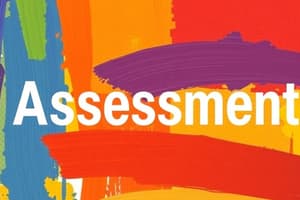Podcast
Questions and Answers
What are the key sections a well-organized cover letter should include?
What are the key sections a well-organized cover letter should include?
The key sections are introduction, body, and conclusion.
How does a strong closing statement benefit a cover letter?
How does a strong closing statement benefit a cover letter?
A strong closing statement reinforces the candidate's confidence and encourages further discussion.
What does a rating of 5 indicate on the cover letter assessment scale?
What does a rating of 5 indicate on the cover letter assessment scale?
A rating of 5 indicates that the cover letter is exceptionally well-written, tailored, and professional with no errors.
Explain how a rating scale facilitates the comparison of cover letters across different candidates.
Explain how a rating scale facilitates the comparison of cover letters across different candidates.
What is one main advantage of using a rating scale for cover letter evaluation?
What is one main advantage of using a rating scale for cover letter evaluation?
What is the purpose of a cover letter in a portfolio assessment?
What is the purpose of a cover letter in a portfolio assessment?
List two essential elements that must be included in a student’s portfolio.
List two essential elements that must be included in a student’s portfolio.
How does portfolio assessment cater to a heterogeneous class?
How does portfolio assessment cater to a heterogeneous class?
What is the role of reflections in portfolio assessment?
What is the role of reflections in portfolio assessment?
What should educators consider when identifying teaching goals for portfolio assessment?
What should educators consider when identifying teaching goals for portfolio assessment?
Explain why it is important to inform key stakeholders about portfolio assessment.
Explain why it is important to inform key stakeholders about portfolio assessment.
Describe the significance of drafts in the portfolio assessment process.
Describe the significance of drafts in the portfolio assessment process.
What benefits does portfolio assessment provide in developing social skills?
What benefits does portfolio assessment provide in developing social skills?
What is a documentation portfolio and what does it typically include?
What is a documentation portfolio and what does it typically include?
Describe the main purpose of a process portfolio.
Describe the main purpose of a process portfolio.
What does a showcase portfolio focus on?
What does a showcase portfolio focus on?
How does using a rating scale benefit the evaluation of cover letters in portfolios?
How does using a rating scale benefit the evaluation of cover letters in portfolios?
What criteria are important for evaluating the introduction and personalization in cover letters?
What criteria are important for evaluating the introduction and personalization in cover letters?
What should candidates demonstrate regarding skills and job alignment in their cover letters?
What should candidates demonstrate regarding skills and job alignment in their cover letters?
What aspects of tone and language should be considered in cover letter evaluations?
What aspects of tone and language should be considered in cover letter evaluations?
Explain the significance of the rating scale in the context of multiple portfolio evaluations.
Explain the significance of the rating scale in the context of multiple portfolio evaluations.
What is portfolio assessment?
What is portfolio assessment?
What are two key features of portfolio assessment?
What are two key features of portfolio assessment?
How does portfolio assessment promote critical thinking?
How does portfolio assessment promote critical thinking?
What principle ensures that portfolio assessments are unbiased?
What principle ensures that portfolio assessments are unbiased?
What role does student reflection play in portfolio assessment?
What role does student reflection play in portfolio assessment?
Why is authenticity an important principle of portfolio assessment?
Why is authenticity an important principle of portfolio assessment?
How does portfolio assessment differ from traditional testing?
How does portfolio assessment differ from traditional testing?
What is the purpose of having clear goals in portfolio assessment?
What is the purpose of having clear goals in portfolio assessment?
Flashcards
Portfolio Assessment
Portfolio Assessment
A method of evaluating a student's progress and accomplishments by collecting and reviewing their work over time.
Long-term Focus
Long-term Focus
Assessing a student's progress over a longer period, rather than just a single moment in time.
Authentic Tasks
Authentic Tasks
Using real-world examples and applications in assessments.
Student Reflection
Student Reflection
Signup and view all the flashcards
Validity in Portfolio Assessment
Validity in Portfolio Assessment
Signup and view all the flashcards
Reliability in Portfolio Assessment
Reliability in Portfolio Assessment
Signup and view all the flashcards
Student-Centered Assessment
Student-Centered Assessment
Signup and view all the flashcards
Collaborative Assessment
Collaborative Assessment
Signup and view all the flashcards
Cover Letter in Portfolio
Cover Letter in Portfolio
Signup and view all the flashcards
Table of Contents in Portfolio
Table of Contents in Portfolio
Signup and view all the flashcards
Entries in Portfolio
Entries in Portfolio
Signup and view all the flashcards
Dates in Portfolio Entries
Dates in Portfolio Entries
Signup and view all the flashcards
Drafts and Revisions in Portfolio
Drafts and Revisions in Portfolio
Signup and view all the flashcards
Reflections in Portfolio
Reflections in Portfolio
Signup and view all the flashcards
Identifying Teaching Goals in Portfolio Assessment
Identifying Teaching Goals in Portfolio Assessment
Signup and view all the flashcards
Introducing Portfolio Assessment
Introducing Portfolio Assessment
Signup and view all the flashcards
Cover Letter Rating Scale
Cover Letter Rating Scale
Signup and view all the flashcards
Strong Closing Statement
Strong Closing Statement
Signup and view all the flashcards
Call to Action
Call to Action
Signup and view all the flashcards
Well-Organized Cover Letter
Well-Organized Cover Letter
Signup and view all the flashcards
Easy-to-Read Formatting
Easy-to-Read Formatting
Signup and view all the flashcards
Documentation Portfolio
Documentation Portfolio
Signup and view all the flashcards
Process Portfolio
Process Portfolio
Signup and view all the flashcards
Showcase Portfolio
Showcase Portfolio
Signup and view all the flashcards
Rating Scale for Cover Letter Content
Rating Scale for Cover Letter Content
Signup and view all the flashcards
Criteria for Evaluating Cover Letters
Criteria for Evaluating Cover Letters
Signup and view all the flashcards
Purpose of Using a Rating Scale
Purpose of Using a Rating Scale
Signup and view all the flashcards
Introduction and Personalization
Introduction and Personalization
Signup and view all the flashcards
Skills and Job Alignment
Skills and Job Alignment
Signup and view all the flashcards
Study Notes
Portfolio Assessment Methods
- Portfolio assessment evaluates a student's work over time to gauge progress, skills, and accomplishments.
- It systematically collects and reviews various artifacts like assignments, projects, reflections, and other learning evidence.
- This approach assesses student growth, subject mastery, and ability to meet learning goals.
- It's a dynamic and holistic approach; it goes beyond measuring knowledge to highlight best achievements and improvements.
- Portfolios offer a richer and personalized way of assessing learning, valuing innovation, depth, and continuous improvement.
- This method encourages critical thinking and metacognition, involving students in organizing their work, analyzing strengths and weaknesses, and understanding their progress.
Features of Portfolio Assessment
- Collection of student work: Gathering samples of student activities.
- Long-term focus: Assessing progress over a considerable period instead of a single moment.
- Authentic tasks: Using real-world examples and applications.
- Student reflection: Encouraging self-assessment and reflection.
- Multiple criteria: Evaluating various aspects including content, process, and product.
Principles of Portfolio Assessment
- Validity: Aligning assessment with learning objectives.
- Reliability: Maintaining consistent evaluation standards.
- Authenticity: Reflecting real-world contexts.
- Student-centered: Focusing on individual progress.
- Collaborative: Involving students, teachers, and other stakeholders.
- Ongoing: Regular feedback and revison.
- Transparent: Clear criteria and standards.
- Equitable: Fair and unbiased evaluation
Purposes of Portfolio Assessment
- Matches assessment to teaching.
- Has clear goals decided at the beginning of instruction, clear for both teacher and students.
- Gives a profile of learners' abilities regarding depth, breadth, and growth.
- Is a tool for assessing various skills not easily testable in single traditional settings.
- Develops awareness of students' own learning.
- Caters to individuals in heterogeneous classes.
- Develops social skills.
- Develops independent and active learners.
- Improves motivation for learning and achievement.
- Provides opportunity for student-teacher dialogue.
Essential Elements of a Portfolio
- Cover Letter: Summarizes student learning and progress.
- Table of Contents: Lists portfolio contents with page numbers.
- Entries: Includes core items required by the teacher and optional student choices.
- Dates: On all entries to track growth over time.
- Drafts/Rewrites: Include aural/oral, and written product first drafts, as well as corrected/revised versions.
- Reflections: Can occur at different stages (formative and summative) and can be written in the student's first language if necessary.
Stages of Implementing Portfolio Assessment
- Identifying Teaching Goals: Carefully consider desired learning outcomes for students.
- Introducing the Idea: Explain the concept and benefits of portfolio assessment for students.
- Specification of Portfolio Content: Detail the specific content to be included in the portfolio.
- Giving Clear Guidelines: Communicate clear presentation and submission guidelines for the portfolio.
- Informing Key Stakeholders: Inform school officials, parents, and other stakeholders about the new method.
- Development of the Portfolio: Support and encourage both students and teachers. Students need patient and understanding teachers to guide them.
Types of Portfolios
- Documentation Portfolio: A "growth portfolio," includes everything from brainstorming to final products.
- Process Portfolio: Demonstrates all facets of the learning process and includes reflective journals, think logs, and metacognitive processing.
- Showcase Portfolio: Presents the very best student outputs and products for summative evaluation.
Assessing and Evaluating Cover Letters
- Cover Letter Content: Evaluating using a rating scale ensures fairness and consistency when reviewing portfolios.
- Rating Scale: A 5-point scale provides clear criteria for evaluating content including introduction, job alignment, tone, structure, and closing.
- Benefits of Rating Scale: Provides an objective basis for comparison; helps evaluators identify key strengths and areas for improvement in candidates' cover letters.
Criteria for Evaluating Cover Letters
- Introduction and Personalization (Is the candidate's introduction effective? Is the letter tailored?)
- Skills and Job Alignment (Does the candidate align skills and experience with the job description? Are specific examples provided?)
- Professional Tone and Language (Is the letter professional, clear, and concise? Are there grammatical or spelling errors?)
- Structure and Formatting (Is the letter well-organized, with clear introduction, body, and conclusion? Is formatting clean and easy to read?)
- Closing and Call to Action (Does the letter include a strong closing statement? Is there a request for an interview?)
Rating Scale Definitions
- 5 (Excellent): Exceptional, well-written, tailored, professional with no errors.
- 4 (Good): Meets most criteria.
- 3 (Average): Satisfactory but could use more specific examples and polish.
- 2 (Below Average): Generic, noticeable gaps in professionalism and relevance.
- 1 (Poor): Lacks clarity, structure, and relevance, with multiple errors.
Benefits of a Rating Scale
- Objective Evaluation: Ensures every cover letter is evaluated using the same criteria, reducing subjectivity.
- Easy Comparison: Allows for straightforward comparison across various portfolios.
- Focused Feedback: Provides specific, constructive feedback.
Studying That Suits You
Use AI to generate personalized quizzes and flashcards to suit your learning preferences.




